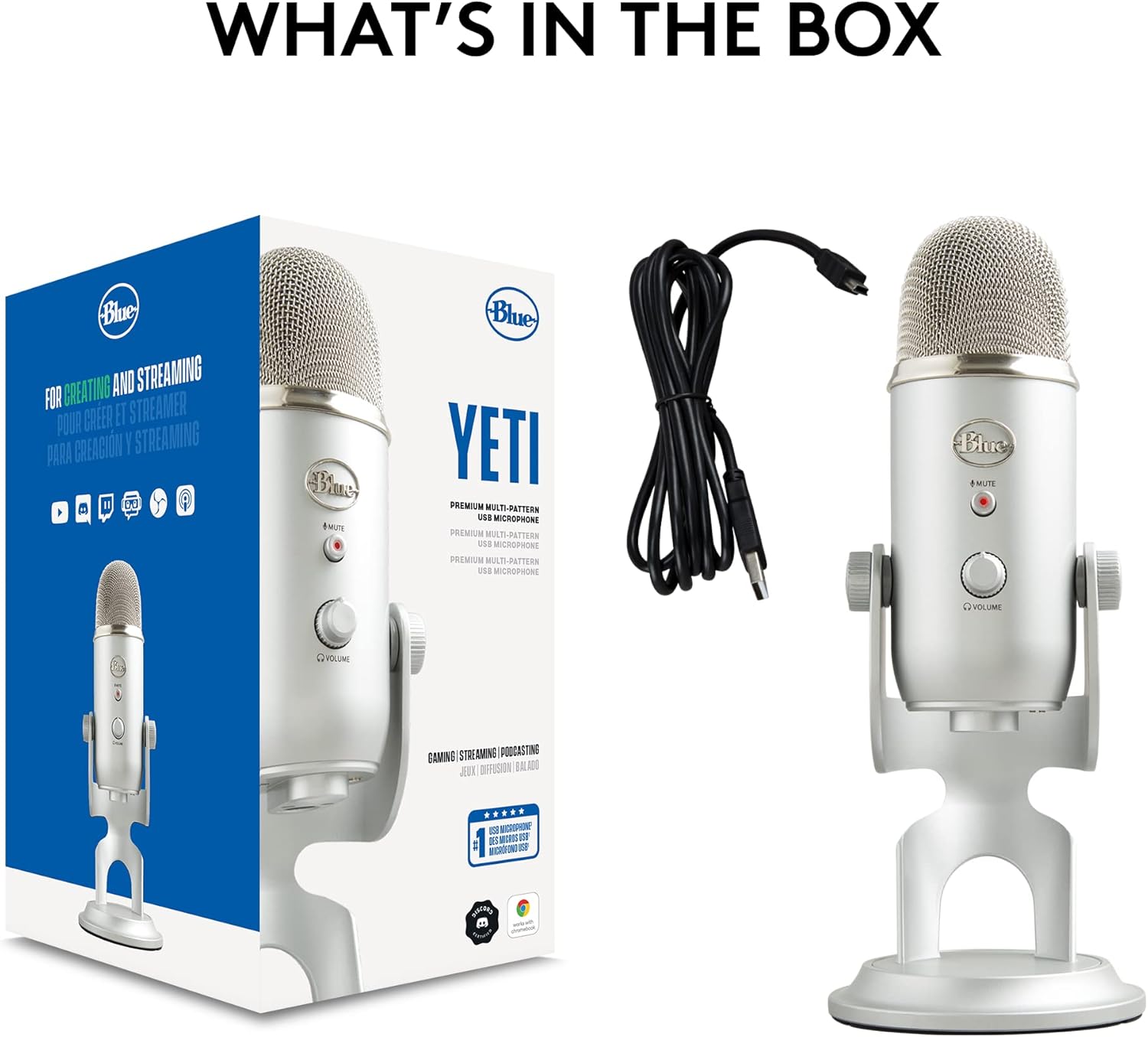Blue Yeti or Blue Yeti Pro:
Blue Microphones revolutionized the USB microphone market with the original Blue Yeti, making professional-quality recording accessible to content creators worldwide. The Yeti series has become synonymous with reliable, plug-and-play audio recording, earning the trust of millions of users from bedroom podcasters to professional streamers.
The Blue Yeti Pro represents an evolution of the original design, incorporating professional features and enhanced connectivity options. Both microphones share the same iconic design philosophy but cater to different segments of the audio recording market in 2025.
Design and Build Quality

The original Blue Yeti features a distinctive retro-futuristic design that has become instantly recognizable in the content creation space. Its heavy-duty steel construction provides excellent stability and durability, while the adjustable stand allows for flexible positioning. The microphone weighs approximately 1.55 pounds, giving it a substantial feel that inspires confidence during recording sessions.
The Yeti’s control panel is elegantly integrated into the microphone body, featuring a prominent mute button with LED indicator, headphone volume control, microphone gain adjustment, and the signature pattern selection knob. This intuitive layout allows for quick adjustments without interrupting your workflow.
On the other hand, The Blue Yeti Pro maintains the same iconic exterior design as its predecessor but incorporates internal improvements that justify its professional designation. The build quality remains exceptional, with the same robust steel construction and stable base that users have come to expect from the Yeti series.
What sets the Pro version apart is its enhanced internal circuitry and additional connectivity options. While visually similar to the standard Yeti, the Pro model features improved preamps and analog-to-digital converters that deliver superior audio quality and lower noise floors.
However, Both microphones share similar dimensions and weight, making them equally suitable for desktop use. However, neither model is designed for frequent transport due to their size and weight. The included desk stands are functional but not particularly travel-friendly, though both models are compatible with standard microphone boom arms for more flexible positioning.
Sound quality
The Blue Yeti delivers impressive audio quality that has made it a staple in home studios worldwide. Its three custom condenser capsules work together to provide clear, detailed recordings with good dynamic range. The microphone performs exceptionally well for voice recording, capturing natural tonality with minimal coloration.
The Yeti’s frequency response ranges from 20Hz to 20kHz, covering the full spectrum of human hearing. Its sensitivity and signal-to-noise ratio are well-suited for most recording environments, though users in noisier spaces may need to implement additional acoustic treatment or post-processing.
On the other hand, The Blue Yeti Pro takes audio quality to the next level with several key improvements. The most significant upgrade is the enhanced analog-to-digital conversion system, which provides higher resolution recording and a lower noise floor. This translates to cleaner recordings with better dynamic range and reduced self-noise.
The Pro model also features improved preamps that deliver better gain staging and more transparent sound reproduction. These improvements are particularly noticeable when recording quieter sources or when working in challenging acoustic environments. The enhanced circuitry provides greater headroom, reducing the likelihood of distortion during louder passages.
When comparing the two microphones side by side, the differences become apparent to trained ears. The Blue Yeti Pro consistently delivers cleaner recordings with better separation between signal and noise. The improved preamps provide more accurate reproduction of source material, making it easier to achieve professional results with minimal post-processing.
The standard Blue Yeti remains an excellent choice for most users, particularly those recording in treated environments with proper technique. However, the Pro model’s enhanced specifications make it more forgiving and suitable for professional applications where audio quality cannot be compromised.
Connectivity
The original Blue Yeti features a straightforward USB connection that has contributed to its popularity among content creators. The plug-and-play nature means users can connect the microphone directly to their computer and begin recording immediately, without the need for additional audio interfaces or complex setup procedures.
The USB connection provides both power and audio signal transmission, making it an ideal solution for desktop recording setups. The microphone is compatible with both Mac and PC systems, automatically installing the necessary drivers when connected. A headphone monitoring jack with dedicated volume control allows for real-time audio monitoring.
On the other hand, The Blue Yeti Pro distinguishes itself with dual connectivity options that cater to both amateur and professional users. In addition to the standard USB connection, the Pro model features XLR output, opening up a world of professional audio possibilities.
The XLR connection allows users to integrate the Blue Yeti Pro into professional audio setups with dedicated audio interfaces, mixing consoles, and other professional equipment. This flexibility makes it suitable for both simple USB recording and complex multi-microphone setups.
When using the XLR connection, the microphone requires phantom power (48V), which is standard on professional audio interfaces and mixing boards. This professional connection typically provides even better audio quality than the USB option, as it bypasses the internal digital conversion entirely.
However, Both microphones feature similar control layouts, but the Pro model includes additional considerations for its dual connectivity. The XLR/USB switch allows users to select their preferred connection method, while maintaining access to all the standard Yeti controls.
The professional connectivity options in the Blue Yeti Pro make it more future-proof for users who may upgrade their recording setup over time. Starting with USB convenience and later transitioning to professional XLR connectivity provides excellent upgrade flexibility.
Polar Pattern
Both the Blue Yeti and Blue Yeti Pro feature the same four polar pattern options, which is one of their strongest selling points. These patterns determine how the microphone captures sound from different directions, making both models versatile for various recording scenarios.
The available patterns include cardioid (front-facing), bidirectional (front and back), omnidirectional (all directions), and stereo (left and right). This variety allows users to adapt their microphone to different recording situations without purchasing additional equipment.
The cardioid pattern is ideal for solo recording, podcasting, and streaming. It captures sound primarily from the front of the microphone while rejecting noise from the sides and rear. This pattern provides the best isolation in typical home recording environments and is the most commonly used setting.
Both microphones perform excellently in cardioid mode, providing clear vocal reproduction with effective background noise rejection. The pattern is forgiving of minor positioning differences and works well for users who may not have extensive microphone technique experience.
The bidirectional pattern captures sound from both the front and back of the microphone while rejecting sound from the sides. This pattern is perfect for two-person interviews, musical duets, or any situation where sources are positioned on opposite sides of the microphone.
Professional users often appreciate this pattern for its ability to create natural-sounding conversations while maintaining good separation between speakers. The Blue Yeti Pro’s enhanced audio quality makes this pattern particularly effective for professional interview scenarios.
The omnidirectional pattern captures sound equally from all directions, making it suitable for recording room ambience, group discussions, or musical ensembles. While both microphones offer this pattern, it requires careful room treatment to avoid unwanted reflections and echo.
The stereo pattern uses the left and right sides of the microphone to create a stereo image, perfect for recording acoustic instruments, ambient soundscapes, or any source where spatial information is important. The Blue Yeti Pro’s improved specifications provide better channel separation and imaging in stereo mode.
Ease of Use
Both the Blue Yeti and Blue Yeti Pro excel in ease of use, maintaining the plug-and-play philosophy that made the original Yeti so popular. Users can connect either microphone to their computer via USB and begin recording within minutes, without the need for additional software or complex configuration.
The intuitive control layout on both microphones makes adjustment simple even for beginners. The large, clearly labeled controls allow for quick changes during recording, while the LED mute button provides clear visual feedback of the microphone’s status.
Both microphones work seamlessly with popular recording software including Audacity, GarageBand, Adobe Audition, and OBS Studio. The standard USB Audio Class drivers ensure compatibility across different operating systems and applications without requiring proprietary software.
Blue provides optional companion software that offers additional features and customization options, though both microphones function perfectly well without it. This approach gives users the choice between simple plug-and-play operation and more advanced control options.
Who is it for?
Both microphones excel for content creation applications including podcasting, streaming, and video production. The Blue Yeti has become a favorite among YouTubers and Twitch streamers due to its reliable performance and professional appearance. Its plug-and-play nature makes it ideal for creators who want quality results without technical complexity.
The Blue Yeti Pro appeals to content creators who demand the highest audio quality or who plan to expand their production capabilities. The XLR connectivity makes it suitable for more complex setups while maintaining the simplicity of USB connection when needed.
Pricing
The Blue Yeti is positioned as a premium consumer microphone, offering professional-level features at an accessible price point. This positioning has made it one of the best-selling USB microphones in history, appealing to serious hobbyists and entry-level professionals .
The microphone’s price reflects its build quality, versatility, and brand reputation. While more expensive than basic USB microphones, the Yeti’s features and performance justify its cost for users who value audio quality and production flexibility.
The Blue Yeti Pro commands a significant premium over the standard model, reflecting its enhanced specifications and professional features. The price difference represents more than just incremental improvements – it’s a step into professional-grade recording equipment.
For users who can utilize the Pro’s advanced features, particularly the XLR connectivity and improved audio quality, the premium pricing represents good value. However, casual users may find the additional cost difficult to justify if they won’t use the professional features.
Pros and Cons
The Blue Yeti excels in delivering professional-quality audio with minimal setup complexity. Its four polar patterns provide exceptional versatility for different recording scenarios, while the plug-and-play USB connectivity appeals to users who want immediate results. The robust build quality ensures long-term reliability, and the iconic design has become a symbol of quality in the content creation community.
The microphone’s intuitive controls and immediate compatibility with popular recording software remove barriers for new users. Its established ecosystem of accessories and widespread compatibility make it a safe choice for various applications.
The standard Blue Yeti’s high sensitivity can be problematic in noisy environments, requiring users to implement acoustic treatment or careful positioning. The USB-only connectivity limits integration with professional audio equipment, and the fixed internal gain structure may not suit all recording scenarios.
On the other hand, The Blue Yeti Pro addresses many limitations of the standard model with enhanced audio quality, lower noise floor, and professional XLR connectivity. The improved preamps and A/D conversion provide cleaner recordings with better dynamic range, while the dual connectivity offers flexibility for different use cases.
Professional users appreciate the ability to integrate the microphone into existing audio chains, and the enhanced specifications make it more suitable for demanding recording applications. The future-proofing provided by XLR connectivity appeals to users with growth plans.
The significant price premium may be difficult to justify for casual users who won’t utilize the professional features. The additional complexity of XLR connectivity may intimidate users who prefer simple plug-and-play operation, and the enhanced features may be overkill for basic recording needs.
Final Thoughts
Both the Blue Yeti and Blue Yeti Pro represent excellent choices in their respective market segments. The standard Blue Yeti continues to set the benchmark for consumer USB microphones, offering professional-quality results with unmatched ease of use. Its versatility, build quality, and proven performance make it a safe choice for most users.
The Blue Yeti Pro elevates the formula with professional-grade enhancements that justify its premium pricing for users who can utilize its advanced features. The enhanced audio quality and XLR connectivity open new possibilities for professional applications while maintaining the plug-and-play convenience that made the Yeti series famous.
